Research Methods Report: Focus Groups, Sampling, and Questionnaires
VerifiedAdded on 2021/05/30
|14
|4102
|30
Report
AI Summary
This report offers a comprehensive overview of research methods, encompassing both qualitative and quantitative approaches. The first part delves into the focus group research method, outlining its rationale, steps involved in conducting a focus group, and considerations for participant selection, moderator selection, planning, interview guide development, recruitment, and data analysis. The second part focuses on questionnaire surveys, discussing sampling methods, including the development of a sampling frame and the use of both probability and non-probability sampling techniques. It also addresses the merits and demerits of qualitative and quantitative research techniques, and the differences between probability and non-probability sampling, providing a well-rounded understanding of various research methodologies.
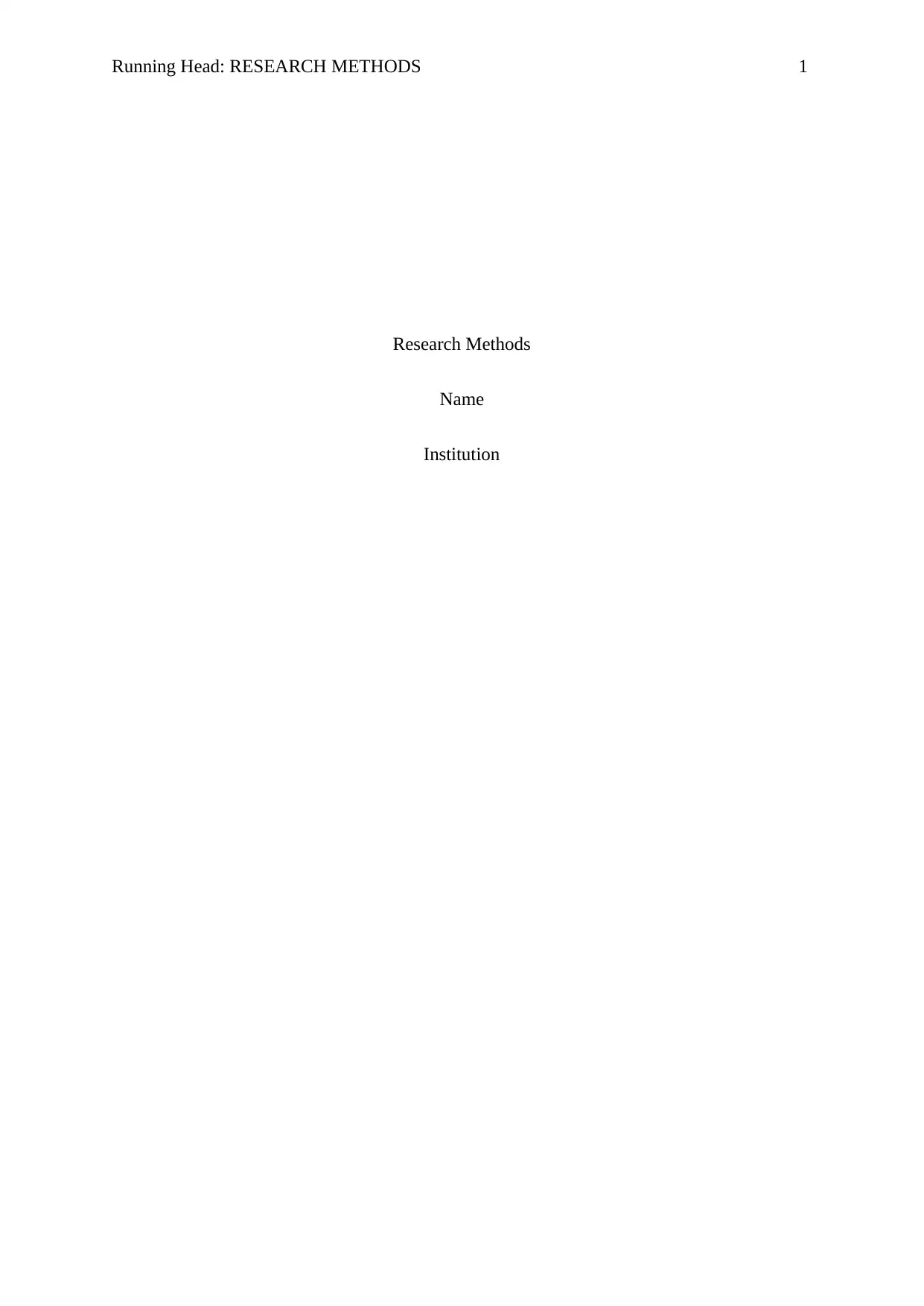
Running Head: RESEARCH METHODS 1
Research Methods
Name
Institution
Research Methods
Name
Institution
Paraphrase This Document
Need a fresh take? Get an instant paraphrase of this document with our AI Paraphraser
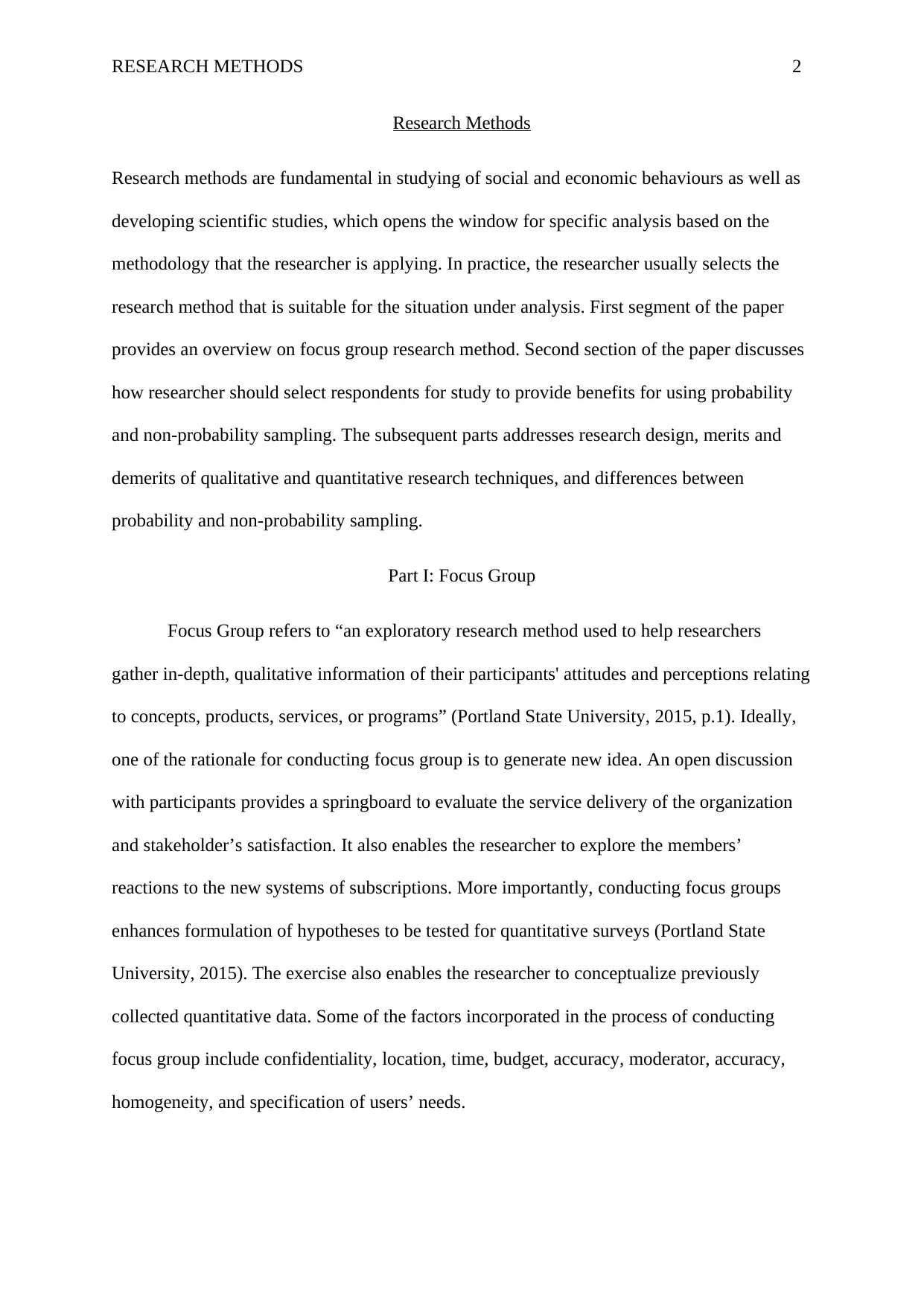
RESEARCH METHODS 2
Research Methods
Research methods are fundamental in studying of social and economic behaviours as well as
developing scientific studies, which opens the window for specific analysis based on the
methodology that the researcher is applying. In practice, the researcher usually selects the
research method that is suitable for the situation under analysis. First segment of the paper
provides an overview on focus group research method. Second section of the paper discusses
how researcher should select respondents for study to provide benefits for using probability
and non-probability sampling. The subsequent parts addresses research design, merits and
demerits of qualitative and quantitative research techniques, and differences between
probability and non-probability sampling.
Part I: Focus Group
Focus Group refers to “an exploratory research method used to help researchers
gather in-depth, qualitative information of their participants' attitudes and perceptions relating
to concepts, products, services, or programs” (Portland State University, 2015, p.1). Ideally,
one of the rationale for conducting focus group is to generate new idea. An open discussion
with participants provides a springboard to evaluate the service delivery of the organization
and stakeholder’s satisfaction. It also enables the researcher to explore the members’
reactions to the new systems of subscriptions. More importantly, conducting focus groups
enhances formulation of hypotheses to be tested for quantitative surveys (Portland State
University, 2015). The exercise also enables the researcher to conceptualize previously
collected quantitative data. Some of the factors incorporated in the process of conducting
focus group include confidentiality, location, time, budget, accuracy, moderator, accuracy,
homogeneity, and specification of users’ needs.
Research Methods
Research methods are fundamental in studying of social and economic behaviours as well as
developing scientific studies, which opens the window for specific analysis based on the
methodology that the researcher is applying. In practice, the researcher usually selects the
research method that is suitable for the situation under analysis. First segment of the paper
provides an overview on focus group research method. Second section of the paper discusses
how researcher should select respondents for study to provide benefits for using probability
and non-probability sampling. The subsequent parts addresses research design, merits and
demerits of qualitative and quantitative research techniques, and differences between
probability and non-probability sampling.
Part I: Focus Group
Focus Group refers to “an exploratory research method used to help researchers
gather in-depth, qualitative information of their participants' attitudes and perceptions relating
to concepts, products, services, or programs” (Portland State University, 2015, p.1). Ideally,
one of the rationale for conducting focus group is to generate new idea. An open discussion
with participants provides a springboard to evaluate the service delivery of the organization
and stakeholder’s satisfaction. It also enables the researcher to explore the members’
reactions to the new systems of subscriptions. More importantly, conducting focus groups
enhances formulation of hypotheses to be tested for quantitative surveys (Portland State
University, 2015). The exercise also enables the researcher to conceptualize previously
collected quantitative data. Some of the factors incorporated in the process of conducting
focus group include confidentiality, location, time, budget, accuracy, moderator, accuracy,
homogeneity, and specification of users’ needs.
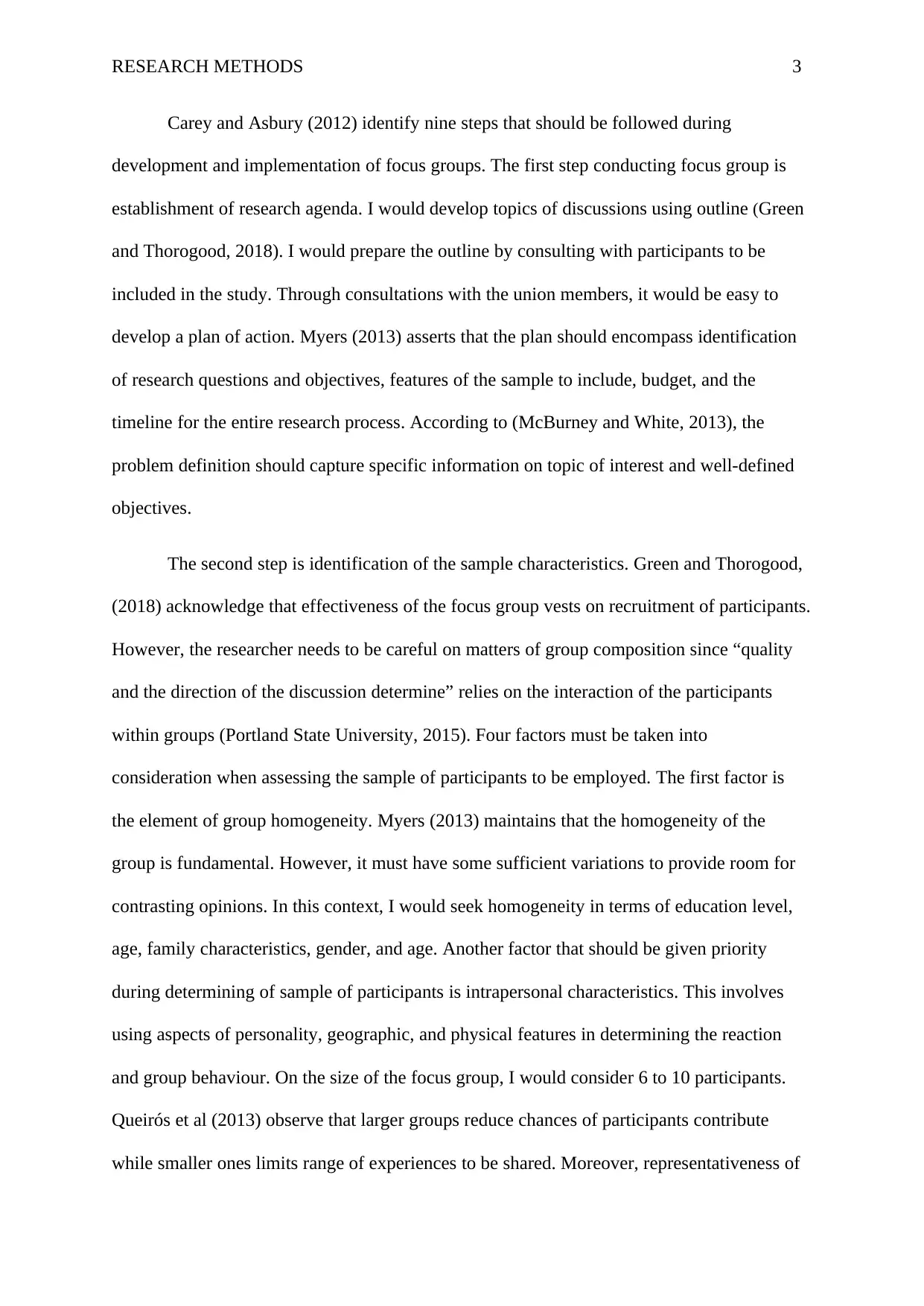
RESEARCH METHODS 3
Carey and Asbury (2012) identify nine steps that should be followed during
development and implementation of focus groups. The first step conducting focus group is
establishment of research agenda. I would develop topics of discussions using outline (Green
and Thorogood, 2018). I would prepare the outline by consulting with participants to be
included in the study. Through consultations with the union members, it would be easy to
develop a plan of action. Myers (2013) asserts that the plan should encompass identification
of research questions and objectives, features of the sample to include, budget, and the
timeline for the entire research process. According to (McBurney and White, 2013), the
problem definition should capture specific information on topic of interest and well-defined
objectives.
The second step is identification of the sample characteristics. Green and Thorogood,
(2018) acknowledge that effectiveness of the focus group vests on recruitment of participants.
However, the researcher needs to be careful on matters of group composition since “quality
and the direction of the discussion determine” relies on the interaction of the participants
within groups (Portland State University, 2015). Four factors must be taken into
consideration when assessing the sample of participants to be employed. The first factor is
the element of group homogeneity. Myers (2013) maintains that the homogeneity of the
group is fundamental. However, it must have some sufficient variations to provide room for
contrasting opinions. In this context, I would seek homogeneity in terms of education level,
age, family characteristics, gender, and age. Another factor that should be given priority
during determining of sample of participants is intrapersonal characteristics. This involves
using aspects of personality, geographic, and physical features in determining the reaction
and group behaviour. On the size of the focus group, I would consider 6 to 10 participants.
Queirós et al (2013) observe that larger groups reduce chances of participants contribute
while smaller ones limits range of experiences to be shared. Moreover, representativeness of
Carey and Asbury (2012) identify nine steps that should be followed during
development and implementation of focus groups. The first step conducting focus group is
establishment of research agenda. I would develop topics of discussions using outline (Green
and Thorogood, 2018). I would prepare the outline by consulting with participants to be
included in the study. Through consultations with the union members, it would be easy to
develop a plan of action. Myers (2013) asserts that the plan should encompass identification
of research questions and objectives, features of the sample to include, budget, and the
timeline for the entire research process. According to (McBurney and White, 2013), the
problem definition should capture specific information on topic of interest and well-defined
objectives.
The second step is identification of the sample characteristics. Green and Thorogood,
(2018) acknowledge that effectiveness of the focus group vests on recruitment of participants.
However, the researcher needs to be careful on matters of group composition since “quality
and the direction of the discussion determine” relies on the interaction of the participants
within groups (Portland State University, 2015). Four factors must be taken into
consideration when assessing the sample of participants to be employed. The first factor is
the element of group homogeneity. Myers (2013) maintains that the homogeneity of the
group is fundamental. However, it must have some sufficient variations to provide room for
contrasting opinions. In this context, I would seek homogeneity in terms of education level,
age, family characteristics, gender, and age. Another factor that should be given priority
during determining of sample of participants is intrapersonal characteristics. This involves
using aspects of personality, geographic, and physical features in determining the reaction
and group behaviour. On the size of the focus group, I would consider 6 to 10 participants.
Queirós et al (2013) observe that larger groups reduce chances of participants contribute
while smaller ones limits range of experiences to be shared. Moreover, representativeness of
⊘ This is a preview!⊘
Do you want full access?
Subscribe today to unlock all pages.

Trusted by 1+ million students worldwide
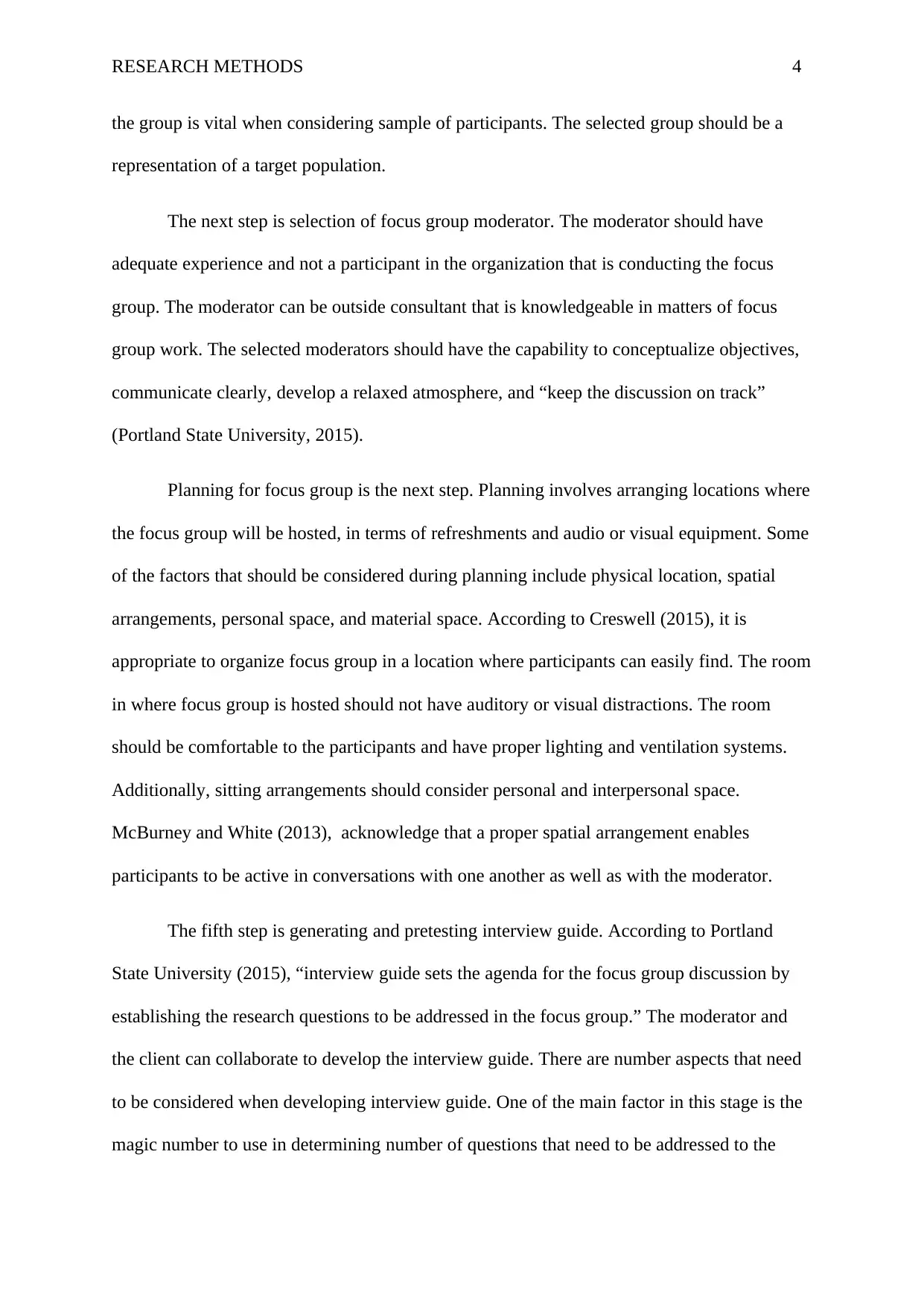
RESEARCH METHODS 4
the group is vital when considering sample of participants. The selected group should be a
representation of a target population.
The next step is selection of focus group moderator. The moderator should have
adequate experience and not a participant in the organization that is conducting the focus
group. The moderator can be outside consultant that is knowledgeable in matters of focus
group work. The selected moderators should have the capability to conceptualize objectives,
communicate clearly, develop a relaxed atmosphere, and “keep the discussion on track”
(Portland State University, 2015).
Planning for focus group is the next step. Planning involves arranging locations where
the focus group will be hosted, in terms of refreshments and audio or visual equipment. Some
of the factors that should be considered during planning include physical location, spatial
arrangements, personal space, and material space. According to Creswell (2015), it is
appropriate to organize focus group in a location where participants can easily find. The room
in where focus group is hosted should not have auditory or visual distractions. The room
should be comfortable to the participants and have proper lighting and ventilation systems.
Additionally, sitting arrangements should consider personal and interpersonal space.
McBurney and White (2013), acknowledge that a proper spatial arrangement enables
participants to be active in conversations with one another as well as with the moderator.
The fifth step is generating and pretesting interview guide. According to Portland
State University (2015), “interview guide sets the agenda for the focus group discussion by
establishing the research questions to be addressed in the focus group.” The moderator and
the client can collaborate to develop the interview guide. There are number aspects that need
to be considered when developing interview guide. One of the main factor in this stage is the
magic number to use in determining number of questions that need to be addressed to the
the group is vital when considering sample of participants. The selected group should be a
representation of a target population.
The next step is selection of focus group moderator. The moderator should have
adequate experience and not a participant in the organization that is conducting the focus
group. The moderator can be outside consultant that is knowledgeable in matters of focus
group work. The selected moderators should have the capability to conceptualize objectives,
communicate clearly, develop a relaxed atmosphere, and “keep the discussion on track”
(Portland State University, 2015).
Planning for focus group is the next step. Planning involves arranging locations where
the focus group will be hosted, in terms of refreshments and audio or visual equipment. Some
of the factors that should be considered during planning include physical location, spatial
arrangements, personal space, and material space. According to Creswell (2015), it is
appropriate to organize focus group in a location where participants can easily find. The room
in where focus group is hosted should not have auditory or visual distractions. The room
should be comfortable to the participants and have proper lighting and ventilation systems.
Additionally, sitting arrangements should consider personal and interpersonal space.
McBurney and White (2013), acknowledge that a proper spatial arrangement enables
participants to be active in conversations with one another as well as with the moderator.
The fifth step is generating and pretesting interview guide. According to Portland
State University (2015), “interview guide sets the agenda for the focus group discussion by
establishing the research questions to be addressed in the focus group.” The moderator and
the client can collaborate to develop the interview guide. There are number aspects that need
to be considered when developing interview guide. One of the main factor in this stage is the
magic number to use in determining number of questions that need to be addressed to the
Paraphrase This Document
Need a fresh take? Get an instant paraphrase of this document with our AI Paraphraser
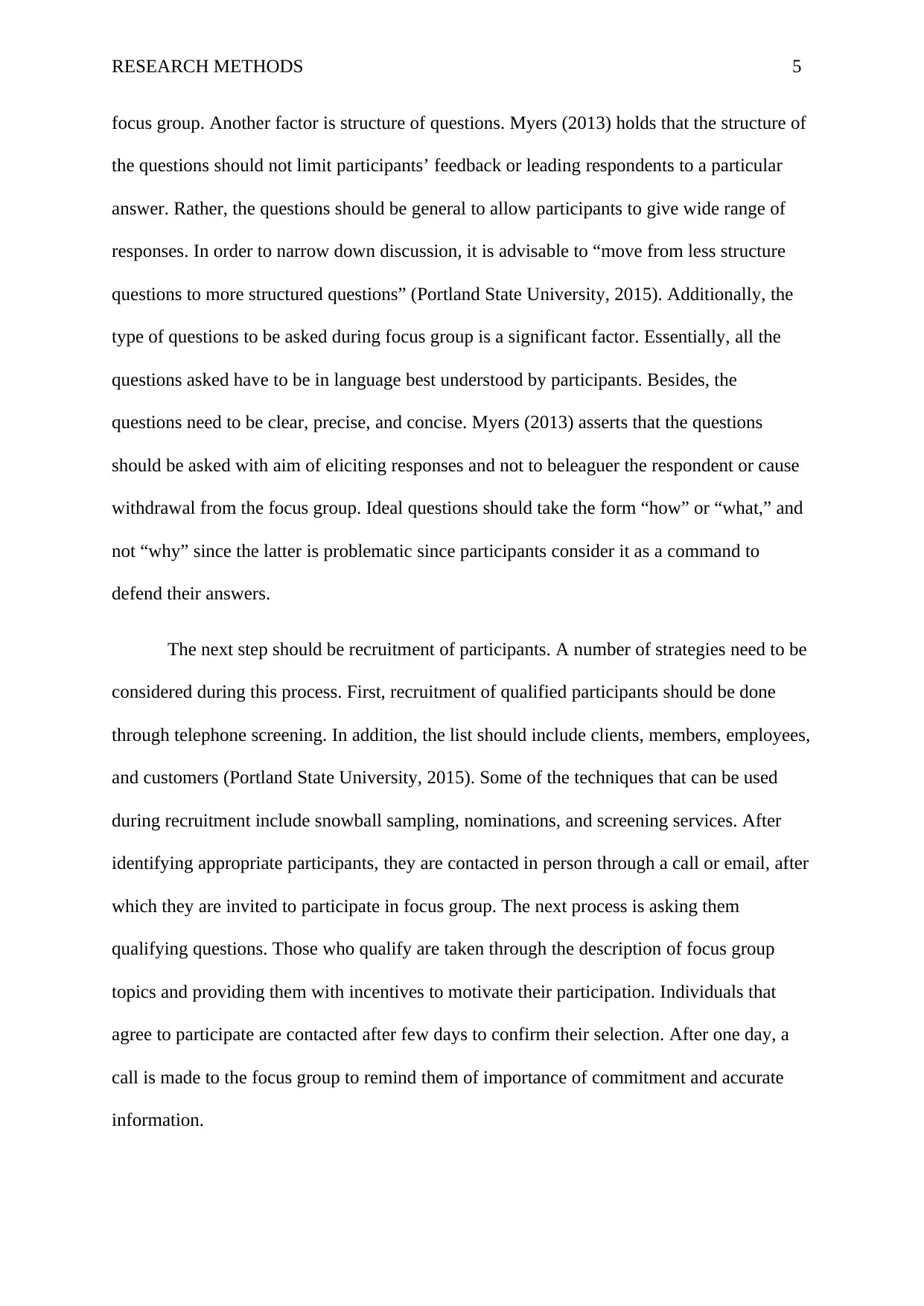
RESEARCH METHODS 5
focus group. Another factor is structure of questions. Myers (2013) holds that the structure of
the questions should not limit participants’ feedback or leading respondents to a particular
answer. Rather, the questions should be general to allow participants to give wide range of
responses. In order to narrow down discussion, it is advisable to “move from less structure
questions to more structured questions” (Portland State University, 2015). Additionally, the
type of questions to be asked during focus group is a significant factor. Essentially, all the
questions asked have to be in language best understood by participants. Besides, the
questions need to be clear, precise, and concise. Myers (2013) asserts that the questions
should be asked with aim of eliciting responses and not to beleaguer the respondent or cause
withdrawal from the focus group. Ideal questions should take the form “how” or “what,” and
not “why” since the latter is problematic since participants consider it as a command to
defend their answers.
The next step should be recruitment of participants. A number of strategies need to be
considered during this process. First, recruitment of qualified participants should be done
through telephone screening. In addition, the list should include clients, members, employees,
and customers (Portland State University, 2015). Some of the techniques that can be used
during recruitment include snowball sampling, nominations, and screening services. After
identifying appropriate participants, they are contacted in person through a call or email, after
which they are invited to participate in focus group. The next process is asking them
qualifying questions. Those who qualify are taken through the description of focus group
topics and providing them with incentives to motivate their participation. Individuals that
agree to participate are contacted after few days to confirm their selection. After one day, a
call is made to the focus group to remind them of importance of commitment and accurate
information.
focus group. Another factor is structure of questions. Myers (2013) holds that the structure of
the questions should not limit participants’ feedback or leading respondents to a particular
answer. Rather, the questions should be general to allow participants to give wide range of
responses. In order to narrow down discussion, it is advisable to “move from less structure
questions to more structured questions” (Portland State University, 2015). Additionally, the
type of questions to be asked during focus group is a significant factor. Essentially, all the
questions asked have to be in language best understood by participants. Besides, the
questions need to be clear, precise, and concise. Myers (2013) asserts that the questions
should be asked with aim of eliciting responses and not to beleaguer the respondent or cause
withdrawal from the focus group. Ideal questions should take the form “how” or “what,” and
not “why” since the latter is problematic since participants consider it as a command to
defend their answers.
The next step should be recruitment of participants. A number of strategies need to be
considered during this process. First, recruitment of qualified participants should be done
through telephone screening. In addition, the list should include clients, members, employees,
and customers (Portland State University, 2015). Some of the techniques that can be used
during recruitment include snowball sampling, nominations, and screening services. After
identifying appropriate participants, they are contacted in person through a call or email, after
which they are invited to participate in focus group. The next process is asking them
qualifying questions. Those who qualify are taken through the description of focus group
topics and providing them with incentives to motivate their participation. Individuals that
agree to participate are contacted after few days to confirm their selection. After one day, a
call is made to the focus group to remind them of importance of commitment and accurate
information.
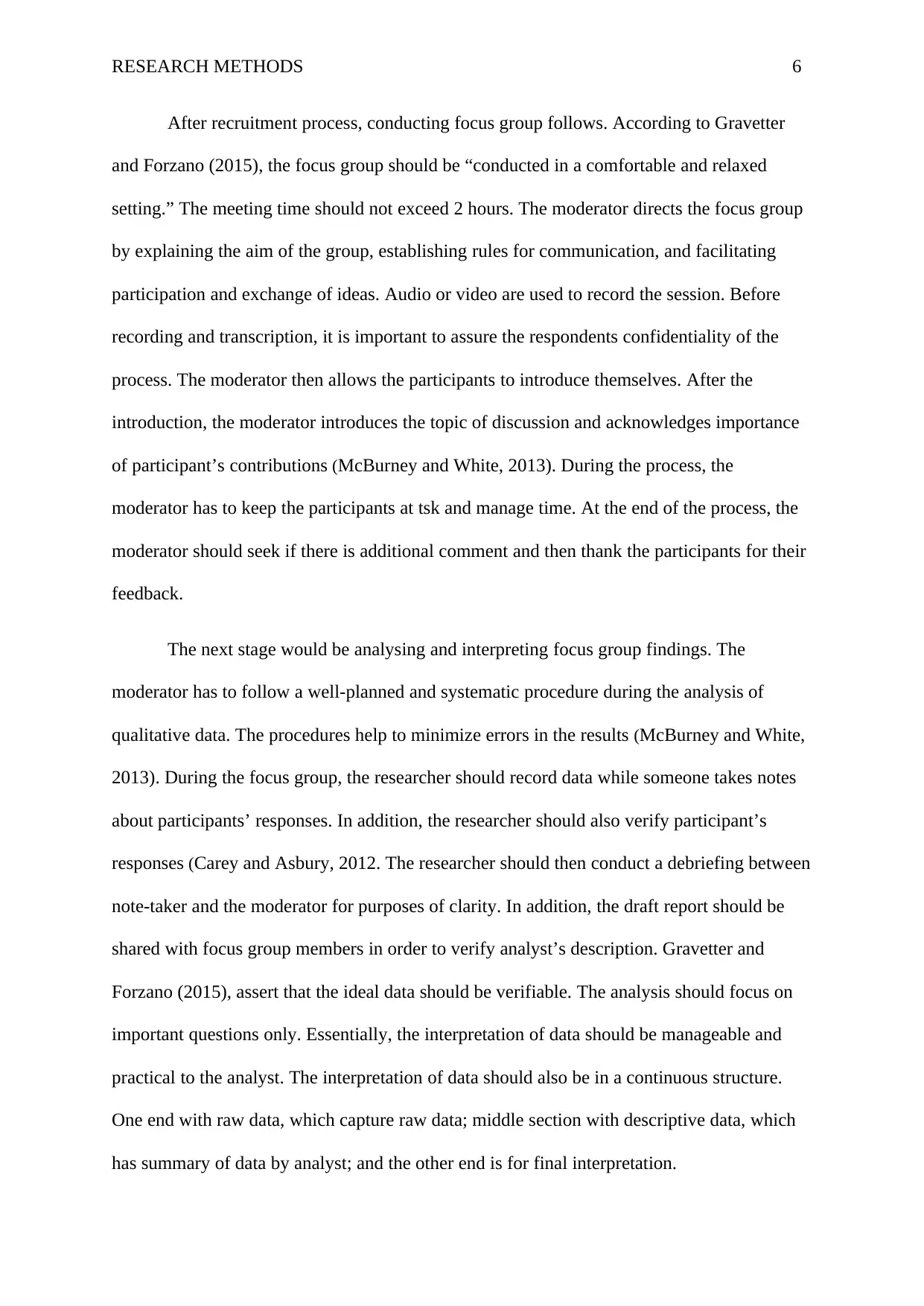
RESEARCH METHODS 6
After recruitment process, conducting focus group follows. According to Gravetter
and Forzano (2015), the focus group should be “conducted in a comfortable and relaxed
setting.” The meeting time should not exceed 2 hours. The moderator directs the focus group
by explaining the aim of the group, establishing rules for communication, and facilitating
participation and exchange of ideas. Audio or video are used to record the session. Before
recording and transcription, it is important to assure the respondents confidentiality of the
process. The moderator then allows the participants to introduce themselves. After the
introduction, the moderator introduces the topic of discussion and acknowledges importance
of participant’s contributions (McBurney and White, 2013). During the process, the
moderator has to keep the participants at tsk and manage time. At the end of the process, the
moderator should seek if there is additional comment and then thank the participants for their
feedback.
The next stage would be analysing and interpreting focus group findings. The
moderator has to follow a well-planned and systematic procedure during the analysis of
qualitative data. The procedures help to minimize errors in the results (McBurney and White,
2013). During the focus group, the researcher should record data while someone takes notes
about participants’ responses. In addition, the researcher should also verify participant’s
responses (Carey and Asbury, 2012. The researcher should then conduct a debriefing between
note-taker and the moderator for purposes of clarity. In addition, the draft report should be
shared with focus group members in order to verify analyst’s description. Gravetter and
Forzano (2015), assert that the ideal data should be verifiable. The analysis should focus on
important questions only. Essentially, the interpretation of data should be manageable and
practical to the analyst. The interpretation of data should also be in a continuous structure.
One end with raw data, which capture raw data; middle section with descriptive data, which
has summary of data by analyst; and the other end is for final interpretation.
After recruitment process, conducting focus group follows. According to Gravetter
and Forzano (2015), the focus group should be “conducted in a comfortable and relaxed
setting.” The meeting time should not exceed 2 hours. The moderator directs the focus group
by explaining the aim of the group, establishing rules for communication, and facilitating
participation and exchange of ideas. Audio or video are used to record the session. Before
recording and transcription, it is important to assure the respondents confidentiality of the
process. The moderator then allows the participants to introduce themselves. After the
introduction, the moderator introduces the topic of discussion and acknowledges importance
of participant’s contributions (McBurney and White, 2013). During the process, the
moderator has to keep the participants at tsk and manage time. At the end of the process, the
moderator should seek if there is additional comment and then thank the participants for their
feedback.
The next stage would be analysing and interpreting focus group findings. The
moderator has to follow a well-planned and systematic procedure during the analysis of
qualitative data. The procedures help to minimize errors in the results (McBurney and White,
2013). During the focus group, the researcher should record data while someone takes notes
about participants’ responses. In addition, the researcher should also verify participant’s
responses (Carey and Asbury, 2012. The researcher should then conduct a debriefing between
note-taker and the moderator for purposes of clarity. In addition, the draft report should be
shared with focus group members in order to verify analyst’s description. Gravetter and
Forzano (2015), assert that the ideal data should be verifiable. The analysis should focus on
important questions only. Essentially, the interpretation of data should be manageable and
practical to the analyst. The interpretation of data should also be in a continuous structure.
One end with raw data, which capture raw data; middle section with descriptive data, which
has summary of data by analyst; and the other end is for final interpretation.
⊘ This is a preview!⊘
Do you want full access?
Subscribe today to unlock all pages.

Trusted by 1+ million students worldwide
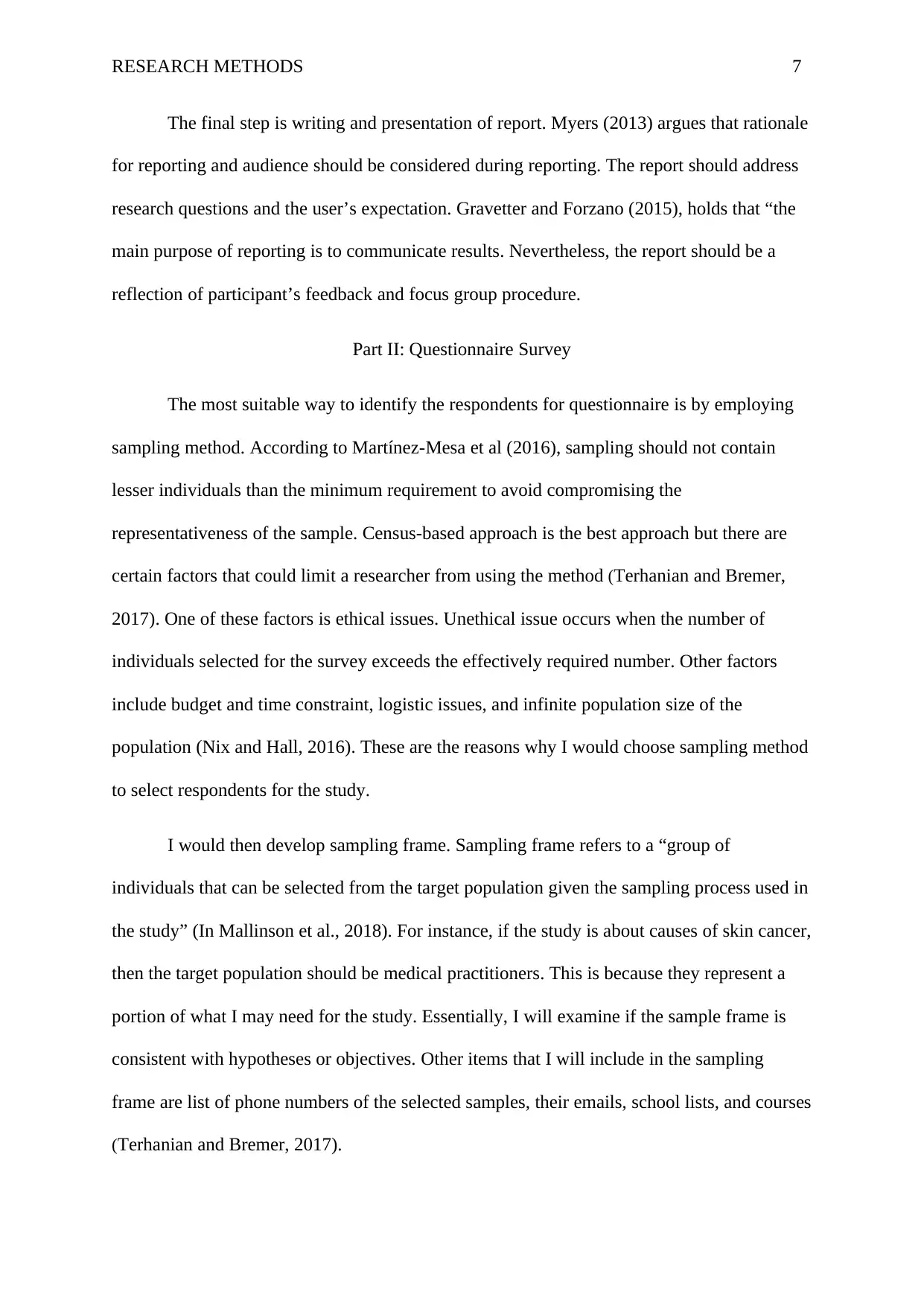
RESEARCH METHODS 7
The final step is writing and presentation of report. Myers (2013) argues that rationale
for reporting and audience should be considered during reporting. The report should address
research questions and the user’s expectation. Gravetter and Forzano (2015), holds that “the
main purpose of reporting is to communicate results. Nevertheless, the report should be a
reflection of participant’s feedback and focus group procedure.
Part II: Questionnaire Survey
The most suitable way to identify the respondents for questionnaire is by employing
sampling method. According to Martínez-Mesa et al (2016), sampling should not contain
lesser individuals than the minimum requirement to avoid compromising the
representativeness of the sample. Census-based approach is the best approach but there are
certain factors that could limit a researcher from using the method (Terhanian and Bremer,
2017). One of these factors is ethical issues. Unethical issue occurs when the number of
individuals selected for the survey exceeds the effectively required number. Other factors
include budget and time constraint, logistic issues, and infinite population size of the
population (Nix and Hall, 2016). These are the reasons why I would choose sampling method
to select respondents for the study.
I would then develop sampling frame. Sampling frame refers to a “group of
individuals that can be selected from the target population given the sampling process used in
the study” (In Mallinson et al., 2018). For instance, if the study is about causes of skin cancer,
then the target population should be medical practitioners. This is because they represent a
portion of what I may need for the study. Essentially, I will examine if the sample frame is
consistent with hypotheses or objectives. Other items that I will include in the sampling
frame are list of phone numbers of the selected samples, their emails, school lists, and courses
(Terhanian and Bremer, 2017).
The final step is writing and presentation of report. Myers (2013) argues that rationale
for reporting and audience should be considered during reporting. The report should address
research questions and the user’s expectation. Gravetter and Forzano (2015), holds that “the
main purpose of reporting is to communicate results. Nevertheless, the report should be a
reflection of participant’s feedback and focus group procedure.
Part II: Questionnaire Survey
The most suitable way to identify the respondents for questionnaire is by employing
sampling method. According to Martínez-Mesa et al (2016), sampling should not contain
lesser individuals than the minimum requirement to avoid compromising the
representativeness of the sample. Census-based approach is the best approach but there are
certain factors that could limit a researcher from using the method (Terhanian and Bremer,
2017). One of these factors is ethical issues. Unethical issue occurs when the number of
individuals selected for the survey exceeds the effectively required number. Other factors
include budget and time constraint, logistic issues, and infinite population size of the
population (Nix and Hall, 2016). These are the reasons why I would choose sampling method
to select respondents for the study.
I would then develop sampling frame. Sampling frame refers to a “group of
individuals that can be selected from the target population given the sampling process used in
the study” (In Mallinson et al., 2018). For instance, if the study is about causes of skin cancer,
then the target population should be medical practitioners. This is because they represent a
portion of what I may need for the study. Essentially, I will examine if the sample frame is
consistent with hypotheses or objectives. Other items that I will include in the sampling
frame are list of phone numbers of the selected samples, their emails, school lists, and courses
(Terhanian and Bremer, 2017).
Paraphrase This Document
Need a fresh take? Get an instant paraphrase of this document with our AI Paraphraser
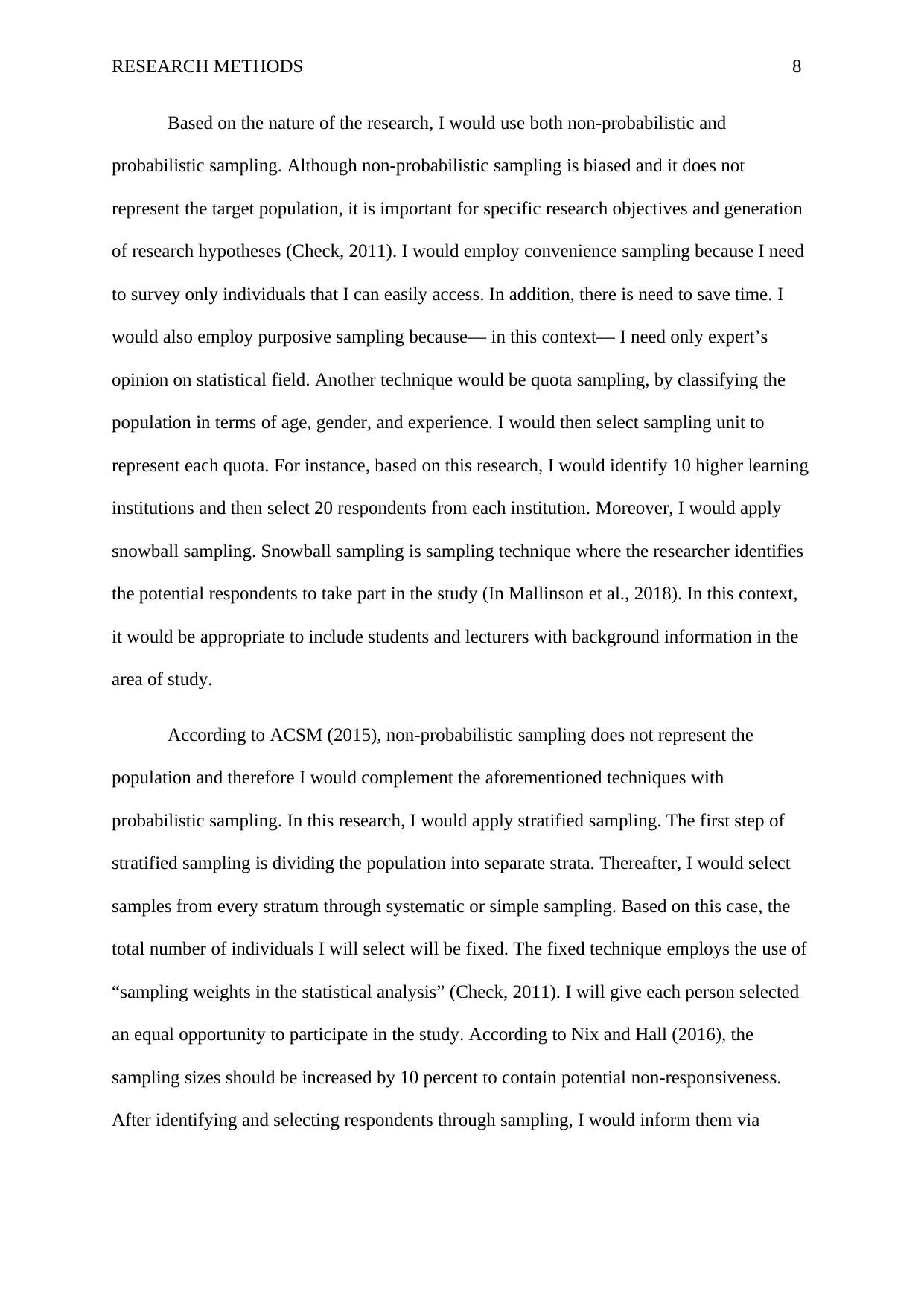
RESEARCH METHODS 8
Based on the nature of the research, I would use both non-probabilistic and
probabilistic sampling. Although non-probabilistic sampling is biased and it does not
represent the target population, it is important for specific research objectives and generation
of research hypotheses (Check, 2011). I would employ convenience sampling because I need
to survey only individuals that I can easily access. In addition, there is need to save time. I
would also employ purposive sampling because— in this context— I need only expert’s
opinion on statistical field. Another technique would be quota sampling, by classifying the
population in terms of age, gender, and experience. I would then select sampling unit to
represent each quota. For instance, based on this research, I would identify 10 higher learning
institutions and then select 20 respondents from each institution. Moreover, I would apply
snowball sampling. Snowball sampling is sampling technique where the researcher identifies
the potential respondents to take part in the study (In Mallinson et al., 2018). In this context,
it would be appropriate to include students and lecturers with background information in the
area of study.
According to ACSM (2015), non-probabilistic sampling does not represent the
population and therefore I would complement the aforementioned techniques with
probabilistic sampling. In this research, I would apply stratified sampling. The first step of
stratified sampling is dividing the population into separate strata. Thereafter, I would select
samples from every stratum through systematic or simple sampling. Based on this case, the
total number of individuals I will select will be fixed. The fixed technique employs the use of
“sampling weights in the statistical analysis” (Check, 2011). I will give each person selected
an equal opportunity to participate in the study. According to Nix and Hall (2016), the
sampling sizes should be increased by 10 percent to contain potential non-responsiveness.
After identifying and selecting respondents through sampling, I would inform them via
Based on the nature of the research, I would use both non-probabilistic and
probabilistic sampling. Although non-probabilistic sampling is biased and it does not
represent the target population, it is important for specific research objectives and generation
of research hypotheses (Check, 2011). I would employ convenience sampling because I need
to survey only individuals that I can easily access. In addition, there is need to save time. I
would also employ purposive sampling because— in this context— I need only expert’s
opinion on statistical field. Another technique would be quota sampling, by classifying the
population in terms of age, gender, and experience. I would then select sampling unit to
represent each quota. For instance, based on this research, I would identify 10 higher learning
institutions and then select 20 respondents from each institution. Moreover, I would apply
snowball sampling. Snowball sampling is sampling technique where the researcher identifies
the potential respondents to take part in the study (In Mallinson et al., 2018). In this context,
it would be appropriate to include students and lecturers with background information in the
area of study.
According to ACSM (2015), non-probabilistic sampling does not represent the
population and therefore I would complement the aforementioned techniques with
probabilistic sampling. In this research, I would apply stratified sampling. The first step of
stratified sampling is dividing the population into separate strata. Thereafter, I would select
samples from every stratum through systematic or simple sampling. Based on this case, the
total number of individuals I will select will be fixed. The fixed technique employs the use of
“sampling weights in the statistical analysis” (Check, 2011). I will give each person selected
an equal opportunity to participate in the study. According to Nix and Hall (2016), the
sampling sizes should be increased by 10 percent to contain potential non-responsiveness.
After identifying and selecting respondents through sampling, I would inform them via
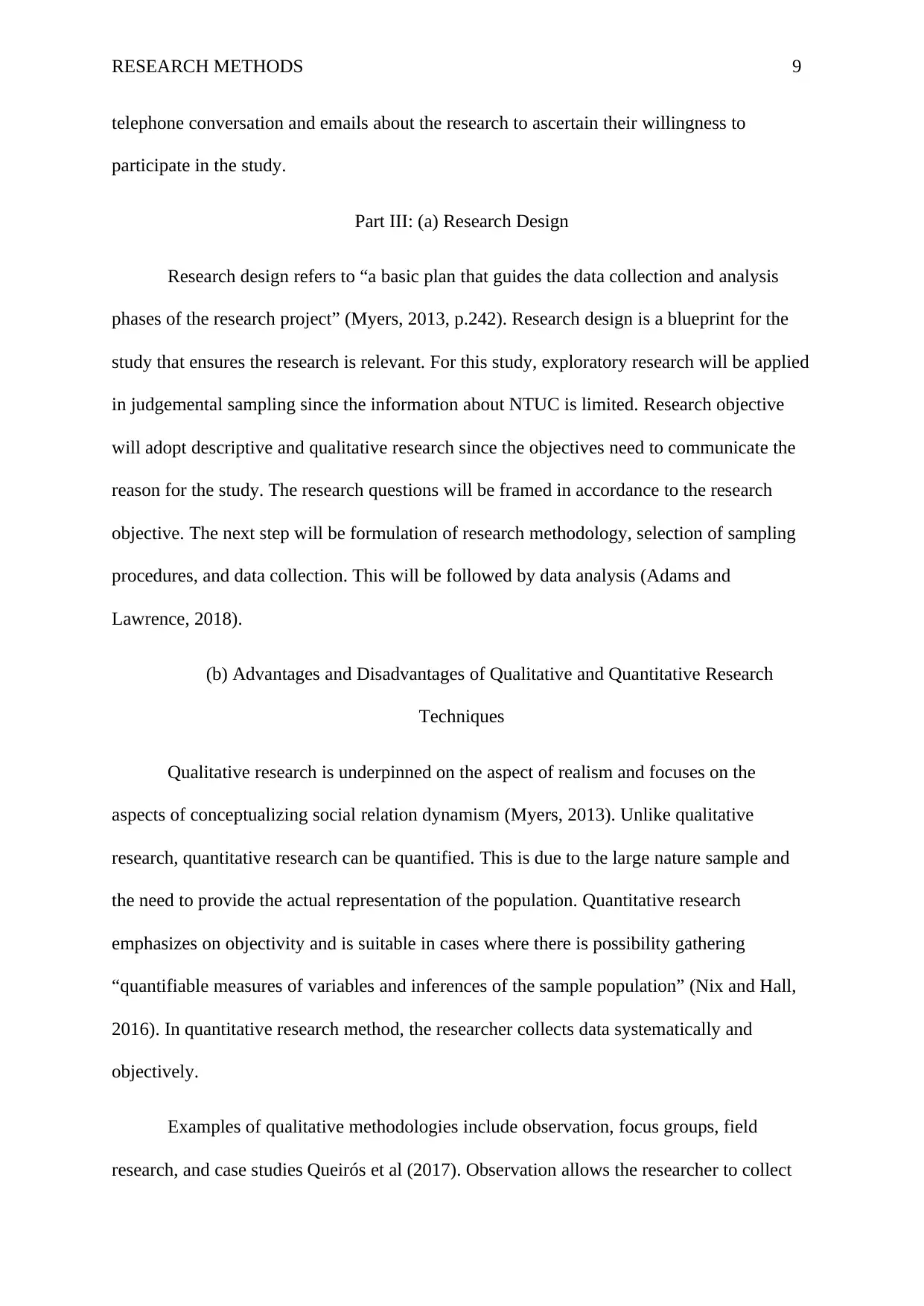
RESEARCH METHODS 9
telephone conversation and emails about the research to ascertain their willingness to
participate in the study.
Part III: (a) Research Design
Research design refers to “a basic plan that guides the data collection and analysis
phases of the research project” (Myers, 2013, p.242). Research design is a blueprint for the
study that ensures the research is relevant. For this study, exploratory research will be applied
in judgemental sampling since the information about NTUC is limited. Research objective
will adopt descriptive and qualitative research since the objectives need to communicate the
reason for the study. The research questions will be framed in accordance to the research
objective. The next step will be formulation of research methodology, selection of sampling
procedures, and data collection. This will be followed by data analysis (Adams and
Lawrence, 2018).
(b) Advantages and Disadvantages of Qualitative and Quantitative Research
Techniques
Qualitative research is underpinned on the aspect of realism and focuses on the
aspects of conceptualizing social relation dynamism (Myers, 2013). Unlike qualitative
research, quantitative research can be quantified. This is due to the large nature sample and
the need to provide the actual representation of the population. Quantitative research
emphasizes on objectivity and is suitable in cases where there is possibility gathering
“quantifiable measures of variables and inferences of the sample population” (Nix and Hall,
2016). In quantitative research method, the researcher collects data systematically and
objectively.
Examples of qualitative methodologies include observation, focus groups, field
research, and case studies Queirós et al (2017). Observation allows the researcher to collect
telephone conversation and emails about the research to ascertain their willingness to
participate in the study.
Part III: (a) Research Design
Research design refers to “a basic plan that guides the data collection and analysis
phases of the research project” (Myers, 2013, p.242). Research design is a blueprint for the
study that ensures the research is relevant. For this study, exploratory research will be applied
in judgemental sampling since the information about NTUC is limited. Research objective
will adopt descriptive and qualitative research since the objectives need to communicate the
reason for the study. The research questions will be framed in accordance to the research
objective. The next step will be formulation of research methodology, selection of sampling
procedures, and data collection. This will be followed by data analysis (Adams and
Lawrence, 2018).
(b) Advantages and Disadvantages of Qualitative and Quantitative Research
Techniques
Qualitative research is underpinned on the aspect of realism and focuses on the
aspects of conceptualizing social relation dynamism (Myers, 2013). Unlike qualitative
research, quantitative research can be quantified. This is due to the large nature sample and
the need to provide the actual representation of the population. Quantitative research
emphasizes on objectivity and is suitable in cases where there is possibility gathering
“quantifiable measures of variables and inferences of the sample population” (Nix and Hall,
2016). In quantitative research method, the researcher collects data systematically and
objectively.
Examples of qualitative methodologies include observation, focus groups, field
research, and case studies Queirós et al (2017). Observation allows the researcher to collect
⊘ This is a preview!⊘
Do you want full access?
Subscribe today to unlock all pages.

Trusted by 1+ million students worldwide
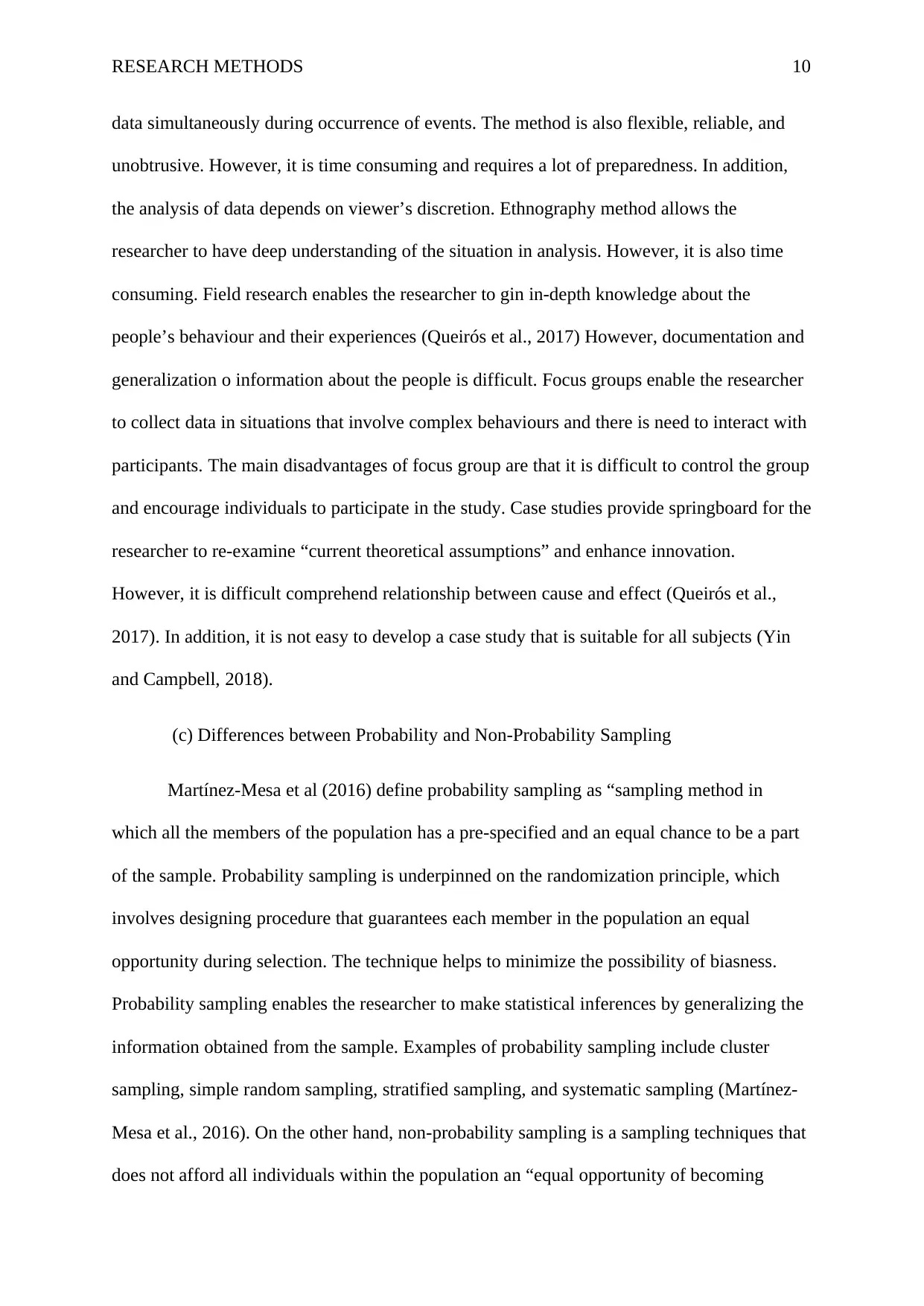
RESEARCH METHODS 10
data simultaneously during occurrence of events. The method is also flexible, reliable, and
unobtrusive. However, it is time consuming and requires a lot of preparedness. In addition,
the analysis of data depends on viewer’s discretion. Ethnography method allows the
researcher to have deep understanding of the situation in analysis. However, it is also time
consuming. Field research enables the researcher to gin in-depth knowledge about the
people’s behaviour and their experiences (Queirós et al., 2017) However, documentation and
generalization o information about the people is difficult. Focus groups enable the researcher
to collect data in situations that involve complex behaviours and there is need to interact with
participants. The main disadvantages of focus group are that it is difficult to control the group
and encourage individuals to participate in the study. Case studies provide springboard for the
researcher to re-examine “current theoretical assumptions” and enhance innovation.
However, it is difficult comprehend relationship between cause and effect (Queirós et al.,
2017). In addition, it is not easy to develop a case study that is suitable for all subjects (Yin
and Campbell, 2018).
(c) Differences between Probability and Non-Probability Sampling
Martínez-Mesa et al (2016) define probability sampling as “sampling method in
which all the members of the population has a pre-specified and an equal chance to be a part
of the sample. Probability sampling is underpinned on the randomization principle, which
involves designing procedure that guarantees each member in the population an equal
opportunity during selection. The technique helps to minimize the possibility of biasness.
Probability sampling enables the researcher to make statistical inferences by generalizing the
information obtained from the sample. Examples of probability sampling include cluster
sampling, simple random sampling, stratified sampling, and systematic sampling (Martínez-
Mesa et al., 2016). On the other hand, non-probability sampling is a sampling techniques that
does not afford all individuals within the population an “equal opportunity of becoming
data simultaneously during occurrence of events. The method is also flexible, reliable, and
unobtrusive. However, it is time consuming and requires a lot of preparedness. In addition,
the analysis of data depends on viewer’s discretion. Ethnography method allows the
researcher to have deep understanding of the situation in analysis. However, it is also time
consuming. Field research enables the researcher to gin in-depth knowledge about the
people’s behaviour and their experiences (Queirós et al., 2017) However, documentation and
generalization o information about the people is difficult. Focus groups enable the researcher
to collect data in situations that involve complex behaviours and there is need to interact with
participants. The main disadvantages of focus group are that it is difficult to control the group
and encourage individuals to participate in the study. Case studies provide springboard for the
researcher to re-examine “current theoretical assumptions” and enhance innovation.
However, it is difficult comprehend relationship between cause and effect (Queirós et al.,
2017). In addition, it is not easy to develop a case study that is suitable for all subjects (Yin
and Campbell, 2018).
(c) Differences between Probability and Non-Probability Sampling
Martínez-Mesa et al (2016) define probability sampling as “sampling method in
which all the members of the population has a pre-specified and an equal chance to be a part
of the sample. Probability sampling is underpinned on the randomization principle, which
involves designing procedure that guarantees each member in the population an equal
opportunity during selection. The technique helps to minimize the possibility of biasness.
Probability sampling enables the researcher to make statistical inferences by generalizing the
information obtained from the sample. Examples of probability sampling include cluster
sampling, simple random sampling, stratified sampling, and systematic sampling (Martínez-
Mesa et al., 2016). On the other hand, non-probability sampling is a sampling techniques that
does not afford all individuals within the population an “equal opportunity of becoming
Paraphrase This Document
Need a fresh take? Get an instant paraphrase of this document with our AI Paraphraser
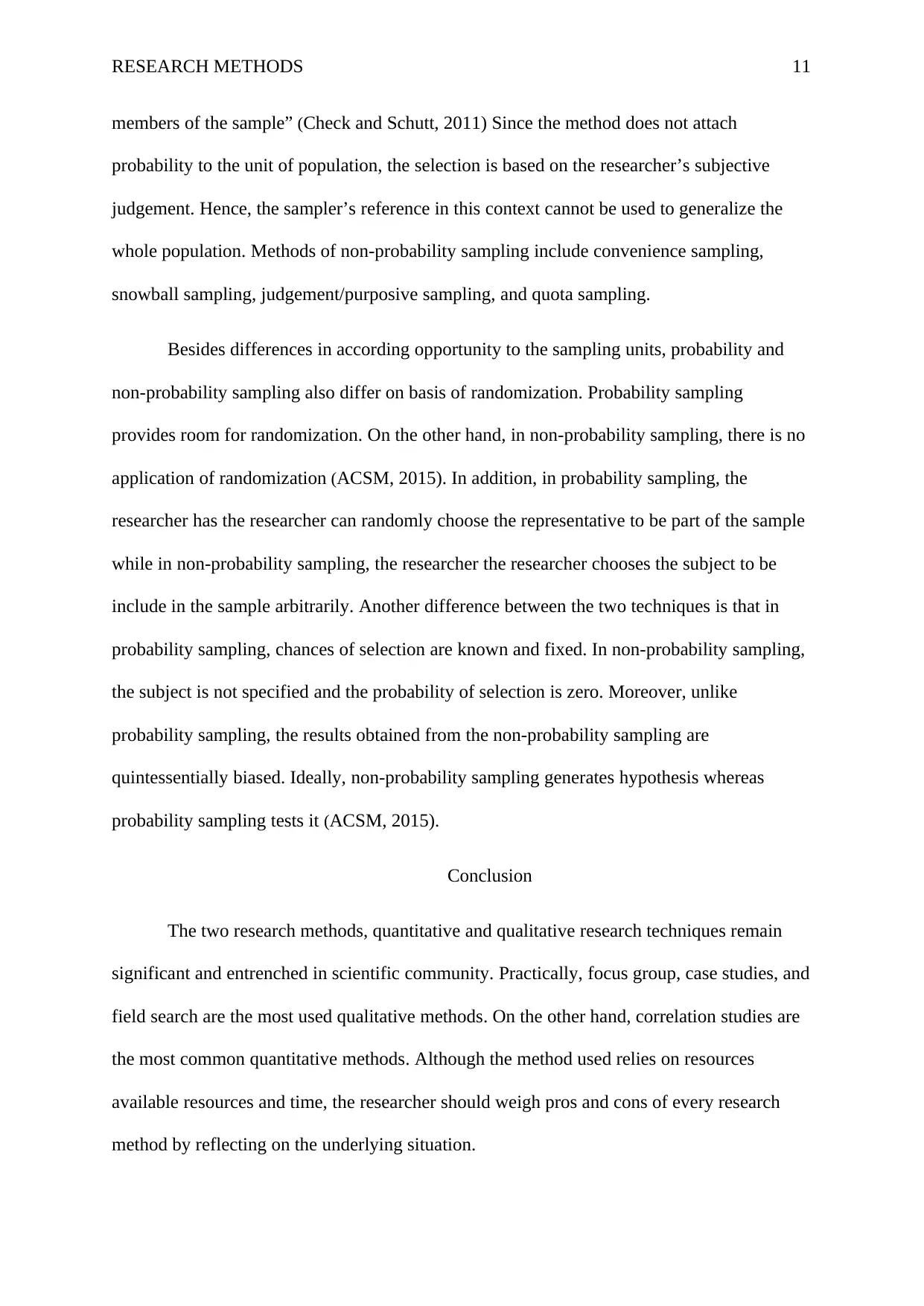
RESEARCH METHODS 11
members of the sample” (Check and Schutt, 2011) Since the method does not attach
probability to the unit of population, the selection is based on the researcher’s subjective
judgement. Hence, the sampler’s reference in this context cannot be used to generalize the
whole population. Methods of non-probability sampling include convenience sampling,
snowball sampling, judgement/purposive sampling, and quota sampling.
Besides differences in according opportunity to the sampling units, probability and
non-probability sampling also differ on basis of randomization. Probability sampling
provides room for randomization. On the other hand, in non-probability sampling, there is no
application of randomization (ACSM, 2015). In addition, in probability sampling, the
researcher has the researcher can randomly choose the representative to be part of the sample
while in non-probability sampling, the researcher the researcher chooses the subject to be
include in the sample arbitrarily. Another difference between the two techniques is that in
probability sampling, chances of selection are known and fixed. In non-probability sampling,
the subject is not specified and the probability of selection is zero. Moreover, unlike
probability sampling, the results obtained from the non-probability sampling are
quintessentially biased. Ideally, non-probability sampling generates hypothesis whereas
probability sampling tests it (ACSM, 2015).
Conclusion
The two research methods, quantitative and qualitative research techniques remain
significant and entrenched in scientific community. Practically, focus group, case studies, and
field search are the most used qualitative methods. On the other hand, correlation studies are
the most common quantitative methods. Although the method used relies on resources
available resources and time, the researcher should weigh pros and cons of every research
method by reflecting on the underlying situation.
members of the sample” (Check and Schutt, 2011) Since the method does not attach
probability to the unit of population, the selection is based on the researcher’s subjective
judgement. Hence, the sampler’s reference in this context cannot be used to generalize the
whole population. Methods of non-probability sampling include convenience sampling,
snowball sampling, judgement/purposive sampling, and quota sampling.
Besides differences in according opportunity to the sampling units, probability and
non-probability sampling also differ on basis of randomization. Probability sampling
provides room for randomization. On the other hand, in non-probability sampling, there is no
application of randomization (ACSM, 2015). In addition, in probability sampling, the
researcher has the researcher can randomly choose the representative to be part of the sample
while in non-probability sampling, the researcher the researcher chooses the subject to be
include in the sample arbitrarily. Another difference between the two techniques is that in
probability sampling, chances of selection are known and fixed. In non-probability sampling,
the subject is not specified and the probability of selection is zero. Moreover, unlike
probability sampling, the results obtained from the non-probability sampling are
quintessentially biased. Ideally, non-probability sampling generates hypothesis whereas
probability sampling tests it (ACSM, 2015).
Conclusion
The two research methods, quantitative and qualitative research techniques remain
significant and entrenched in scientific community. Practically, focus group, case studies, and
field search are the most used qualitative methods. On the other hand, correlation studies are
the most common quantitative methods. Although the method used relies on resources
available resources and time, the researcher should weigh pros and cons of every research
method by reflecting on the underlying situation.
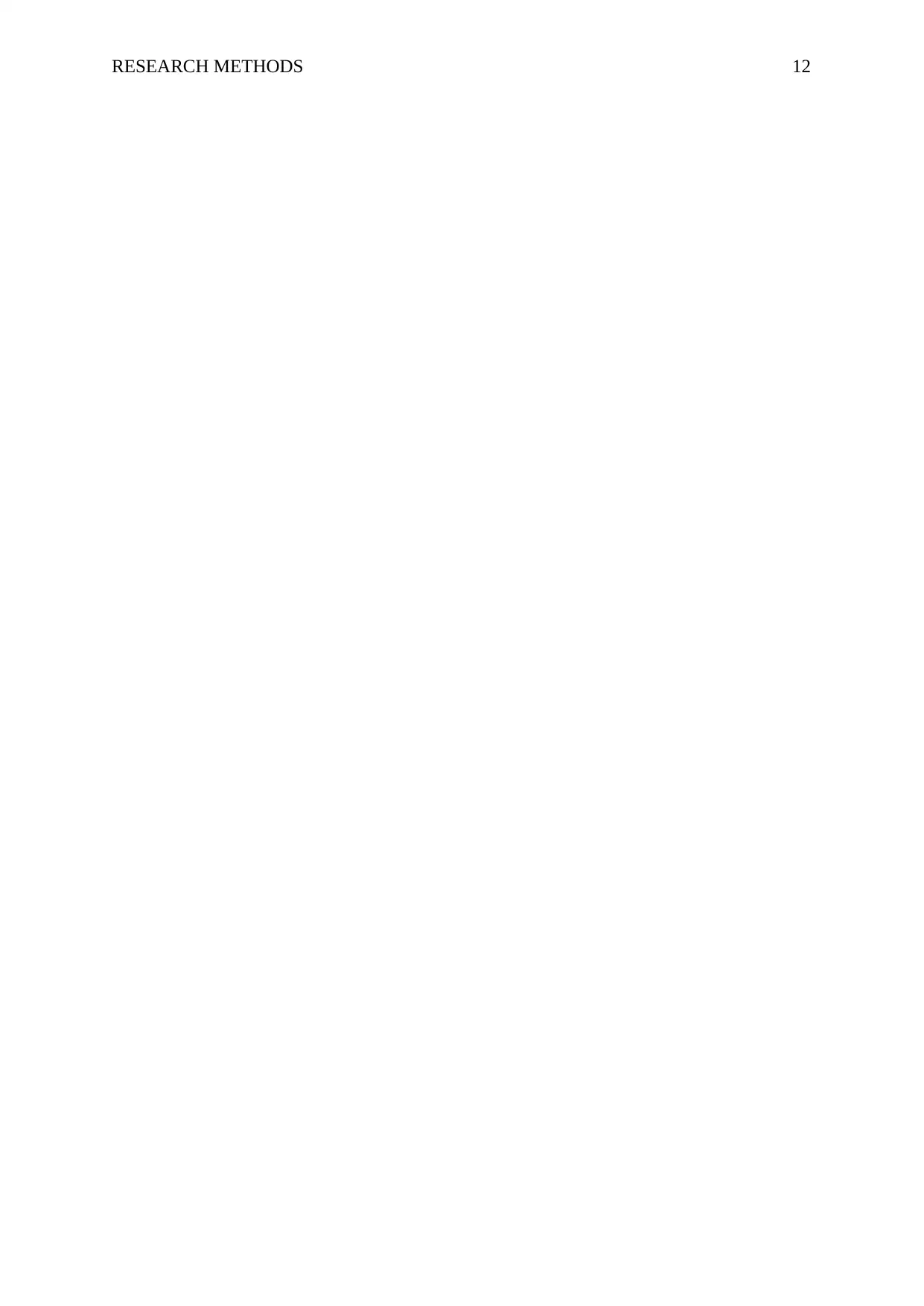
RESEARCH METHODS 12
⊘ This is a preview!⊘
Do you want full access?
Subscribe today to unlock all pages.

Trusted by 1+ million students worldwide
1 out of 14
Related Documents
Your All-in-One AI-Powered Toolkit for Academic Success.
+13062052269
info@desklib.com
Available 24*7 on WhatsApp / Email
![[object Object]](/_next/static/media/star-bottom.7253800d.svg)
Unlock your academic potential
Copyright © 2020–2025 A2Z Services. All Rights Reserved. Developed and managed by ZUCOL.




